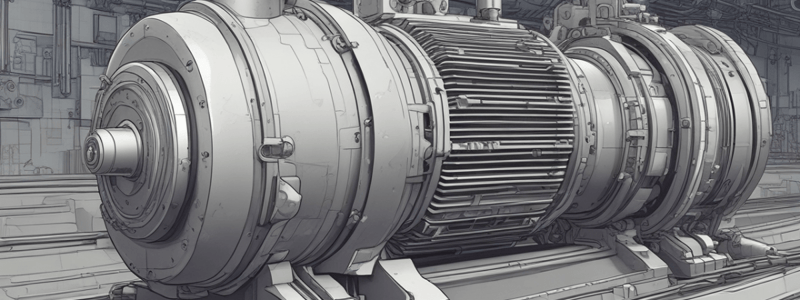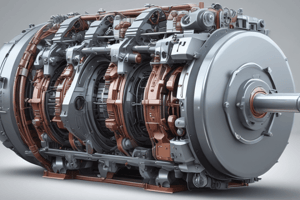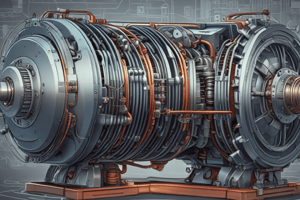Podcast
Questions and Answers
What is the primary principle of operation of an induction motor?
What is the primary principle of operation of an induction motor?
- Electromagnetic induction and Faraday's law (correct)
- Electromagnetic resonance and Ampere's law
- Electromagnetic conduction and Lenz's law
- Electromagnetic transmission and Coulomb's law
What is the primary advantage of brushless DC motors (BLDC) over traditional brushed DC motors?
What is the primary advantage of brushless DC motors (BLDC) over traditional brushed DC motors?
- Lower reliability and shorter lifespan
- Higher cost and larger size
- Higher efficiency and quieter operation (correct)
- Lower efficiency and louder operation
What is the primary application of shaded pole motors?
What is the primary application of shaded pole motors?
- Power tools and kitchen appliances
- Household appliances like fans and refrigerators (correct)
- Electric vehicles and HVAC systems
- Industrial processes and machinery
What is the primary characteristic of synchronous motors?
What is the primary characteristic of synchronous motors?
What is the primary difference between single-phase and three-phase induction motors?
What is the primary difference between single-phase and three-phase induction motors?
What is the main advantage of Capacitor Start-Capacitor Run (CSCR) Motors over CSIR motors?
What is the main advantage of Capacitor Start-Capacitor Run (CSCR) Motors over CSIR motors?
What is the purpose of the auxiliary winding in some single-phase induction motors?
What is the purpose of the auxiliary winding in some single-phase induction motors?
What is the primary purpose of the end rings in a squirrel-cage rotor?
What is the primary purpose of the end rings in a squirrel-cage rotor?
What is the primary characteristic of synchronous motors that makes them suitable for applications where constant speed is required?
What is the primary characteristic of synchronous motors that makes them suitable for applications where constant speed is required?
What is the main difference between Totally Enclosed Fan Cooled (TEFC) Motors and Totally Enclosed Non-Ventilated (TENV) Motors?
What is the main difference between Totally Enclosed Fan Cooled (TEFC) Motors and Totally Enclosed Non-Ventilated (TENV) Motors?
What is the main difference between single-phase induction motors and three-phase induction motors?
What is the main difference between single-phase induction motors and three-phase induction motors?
What is the primary purpose of slip rings in wound rotor motors?
What is the primary purpose of slip rings in wound rotor motors?
What is the purpose of laminated core in the stator of a single-phase induction motor?
What is the purpose of laminated core in the stator of a single-phase induction motor?
What is the principle of operation of induction motors?
What is the principle of operation of induction motors?
What is the method of speed control used in variable speed motors that involves changing the voltage supplied to the motor?
What is the method of speed control used in variable speed motors that involves changing the voltage supplied to the motor?
What is the primary function of end bells in a single-phase induction motor?
What is the primary function of end bells in a single-phase induction motor?
What occurs in the rotor when the stator windings produce a magnetic field?
What occurs in the rotor when the stator windings produce a magnetic field?
What determines the direction of rotation of the rotor?
What determines the direction of rotation of the rotor?
What is a common application of single-phase induction motors in office equipment?
What is a common application of single-phase induction motors in office equipment?
What is a characteristic of universal motors?
What is a characteristic of universal motors?
What is the primary factor determining the speed of an induction motor?
What is the primary factor determining the speed of an induction motor?
What is the typical range of efficiency for induction motors?
What is the typical range of efficiency for induction motors?
What is the main advantage of induction motors in terms of maintenance?
What is the main advantage of induction motors in terms of maintenance?
Which of the following applications is NOT typically associated with AC motors?
Which of the following applications is NOT typically associated with AC motors?
What is the primary reason why AC motors are used in electric vehicles?
What is the primary reason why AC motors are used in electric vehicles?
What is the primary advantage of using a Star-Delta Starter over a Direct-on-Line Starter?
What is the primary advantage of using a Star-Delta Starter over a Direct-on-Line Starter?
Which braking method is most suitable for applications requiring rapid deceleration?
Which braking method is most suitable for applications requiring rapid deceleration?
What is the primary function of an auto-transformer in an Auto-transformer Starter?
What is the primary function of an auto-transformer in an Auto-transformer Starter?
Which type of single-phase induction motor uses a capacitor to create a phase shift during starting and then switches the capacitor out of the circuit once the motor reaches a certain speed?
Which type of single-phase induction motor uses a capacitor to create a phase shift during starting and then switches the capacitor out of the circuit once the motor reaches a certain speed?
What is the primary advantage of using a Variable Frequency Drive (VFD) over other starting methods?
What is the primary advantage of using a Variable Frequency Drive (VFD) over other starting methods?
What is the primary reason why synchronous motors are not self-starting?
What is the primary reason why synchronous motors are not self-starting?
What is the main purpose of the damper windings in a synchronous motor?
What is the main purpose of the damper windings in a synchronous motor?
What is the role of the end rings in a squirrel-cage rotor?
What is the role of the end rings in a squirrel-cage rotor?
What is the primary difference between the stator core of an induction motor and a synchronous motor?
What is the primary difference between the stator core of an induction motor and a synchronous motor?
What is the main advantage of using a salient-pole rotor in a synchronous motor?
What is the main advantage of using a salient-pole rotor in a synchronous motor?
What is the primary reason for the high power-to-weight ratio of universal motors?
What is the primary reason for the high power-to-weight ratio of universal motors?
What is the primary function of the commutator in a universal motor?
What is the primary function of the commutator in a universal motor?
What is the primary effect of increasing the voltage supplied to a universal motor?
What is the primary effect of increasing the voltage supplied to a universal motor?
What is the primary component responsible for delivering current to the rotor windings in a universal motor?
What is the primary component responsible for delivering current to the rotor windings in a universal motor?
What is the primary mechanism by which a universal motor generates torque?
What is the primary mechanism by which a universal motor generates torque?
Flashcards are hidden until you start studying
Study Notes
Classification of AC Motors
- AC motors are categorized based on various factors such as:
- Construction
- Speed control method
- Type of rotor
- Application
Classification Based on Construction
- Synchronous Motors:
- Rotor rotates at the same speed as the rotating magnetic field produced by the stator
- Used in applications where constant speed is required
- Induction Motors (Asynchronous Motors):
- Operate on the principle of electromagnetic induction
- Rotor rotates at a speed slightly less than the synchronous speed of the stator's rotating magnetic field
- Further classified into:
- Single-phase induction motors
- Three-phase induction motors
Classification Based on Rotor Type
- Squirrel Cage Rotor:
- The most common type of rotor in induction motors
- Consists of conductors (aluminum or copper bars) placed in slots of the rotor laminations and short-circuited at both ends by end rings
- Wound Rotor (Slip Ring) Motor:
- Rotor windings are not short-circuited, but are connected to slip rings and external resistors
- Allows for external control of rotor resistance, enabling speed control and improved starting torque
Classification Based on Speed Control Method
- Fixed Speed Motors:
- Operate at a constant speed determined by the frequency of the power supply and the number of poles
- Variable Speed Motors:
- Speed can be varied through methods such as:
- Variable Frequency Drives (VFDs)
- Variable Voltage Control
- Pole Changing Motors
- Speed can be varied through methods such as:
Classification Based on Application
- General Purpose Motors:
- Used in a wide range of applications such as fans, pumps, conveyors, and compressors
- Special Purpose Motors:
- Designed for specific applications, such as:
- Servo Motors
- Stepper Motors
- Hazardous Location Motors
- Fractional Horsepower Motors
- Designed for specific applications, such as:
Construction of AC Motors
- AC motors convert electrical energy into mechanical energy
- Main components of an AC motor:
- Stator
- Rotor
- Bearings
Types of AC Motors
- Induction Motor:
- Operates on the principle of electromagnetic induction
- Simple, rugged, and widely used in various industrial and domestic applications
- Synchronous Motor:
- Operates at a constant speed determined by the frequency of the AC power supply and the number of poles
- Used in applications where precise speed control is required
- Single-Phase Induction Motor:
- Designed to operate on single-phase AC power supplies
- Commonly used in household appliances like fans, pumps, and washing machines
- Three-Phase Induction Motor:
- More efficient and has higher power ratings compared to single-phase motors
- Widely used in industrial applications such as pumps, compressors, conveyor systems, and machine tools
Principle of Working and Characteristics of 3-Phase Induction Motors
- Principle of Working:
- Rotating Magnetic Field (RMF)
- Induced Voltage
- Interaction of Fields
- Torque Production
- Characteristics:
- Self-Starting
- Speed Regulation
- Efficiency
- Torque Characteristics
- Maintenance
- Size and Cost
Applications of AC Motors
- AC motors are widely used in various applications such as:
- Industrial Machinery
- HVAC Systems
- Household Appliances
- Electric Vehicles (EVs)
- Power Tools
- Pumps and Compressors
- Renewable Energy
- Transportation Systems
- Automation and Robotics
- Medical Equipment
Starting and Braking of 3-Phase Induction Motors
- Starting methods:
- Direct-on-Line (DOL) Starter
- Star-Delta Starter
- Auto-transformer Starter
- Soft Starter
- Variable Frequency Drive (VFD)
- Braking methods:
- Coasting or Free-wheeling
- Dynamic Braking
- Regenerative Braking (for VFDs)
- Plugging (Reverse Braking)
Classification of Single-Phase Induction Motors
- Based on starting method:
- Split-phase Induction Motors
- Capacitor Start-Induction Run (CSIR) Motors
- Capacitor Start-Capacitor Run (CSCR) Motors
- Based on rotor construction:
- Squirrel Cage Rotor Motors
- Wound Rotor Motors
- Based on type of enclosure:
- Open Drip-proof (ODP) Motors
- Totally Enclosed Fan Cooled (TEFC) Motors
- Totally Enclosed Non-Ventilated (TENV) Motors
- Based on output power and size:
- Fractional horsepower to several horsepower
Construction of Single-Phase Induction Motors
- Stator:
- Laminated core made of thin steel sheets
- Windings
- Rotor:
- Squirrel cage rotor
- Wound rotor
- Bearings:
- Ball or roller bearings depending on the size and application of the motor### Single-Phase Induction Motor
- The stator winding is typically made of copper wire and is wound around the core slots.
- The winding arrangement could be a single-layer or double-layer depending on the motor design.
- The main winding is responsible for generating a magnetic field when energized and is connected directly to the power supply.
- Some single-phase induction motors may also have an auxiliary winding, which is often smaller and has more turns than the main winding.
Rotor Types
- The rotor is the rotating part of the motor and can be of two types: squirrel-cage rotor or wound rotor.
- The squirrel-cage rotor consists of a cylindrical laminated steel core with conductive bars or short-circuited aluminum or copper conductors placed in the slots on the surface.
- The wound rotor has windings similar to those of the stator winding and is connected through slip rings, allowing external resistors or other control elements to be connected.
Bearing System and Housing
- The rotor is supported by bearings, which allow it to rotate smoothly.
- The stator and rotor assemblies are enclosed within a housing, typically made of cast iron or aluminum, to protect them from environmental factors and provide mechanical support.
- End bells are fitted at both ends of the motor to house the bearings and provide mounting points.
Ventilation System
- Ventilation slots or fans are often incorporated into the housing to allow airflow through the motor and dissipate heat generated during operation.
Starting Mechanism
- A starting mechanism such as a centrifugal switch or a starting capacitor may be added to the motor to improve starting performance.
Principle of Operation
- The single-phase induction motor operates on the principle of electromagnetic induction.
- The stator has a set of windings that are energized by a single-phase AC power supply, creating a rotating magnetic field.
- A starting mechanism is necessary to overcome the limitation of the single-phase system.
Working
- The stator windings produce a magnetic field that interacts with the rotor, inducing currents in the rotor bars.
- The interaction between the stator's rotating magnetic field and the rotor's induced magnetic field causes the rotor to rotate.
Applications
- Single-phase induction motors are commonly used in various applications, including household appliances, small industrial applications, office equipment, HVAC systems, agricultural machinery, and power tools.
Universal Motor
Principle of Operation
- The universal motor operates on the principle of electromagnetic induction.
- It can run on both AC and DC power sources due to its unique design.
Components
- Stator: The stationary part of the motor, consisting of a series of windings or coils wound around iron poles.
- Rotor: The rotating part of the motor, typically made of a core with wire windings or conductive bars.
- Commutator: A split metal ring attached to the rotor shaft, divided into segments.
- Brushes: Carbon brushes that maintain electrical contact with the commutator segments.
Working
- When power is supplied to the motor, current flows through both the stator and rotor windings, creating a magnetic field that induces a magnetic field in the rotor.
- Electromagnetic induction occurs, inducing an electromotive force (EMF) in the rotor windings, generating a magnetic field that interacts with the stator's magnetic field.
Torque Generation and Speed Control
- The interaction between the magnetic fields produces a torque on the rotor, causing it to rotate.
- The speed of the universal motor can be controlled by varying the voltage or by using electronic speed control circuits.
Studying That Suits You
Use AI to generate personalized quizzes and flashcards to suit your learning preferences.





